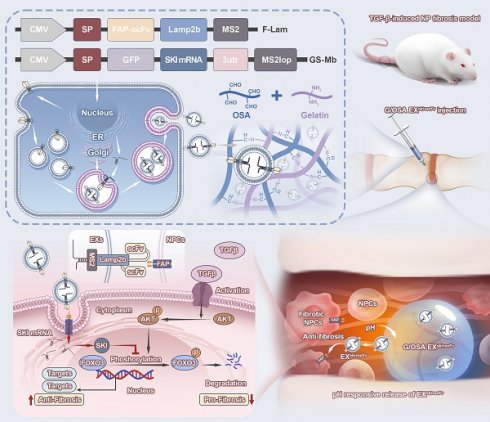13.3
Impact Factor
Theranostics 2025; 15(9):3877-3899. doi:10.7150/thno.107776 This issue Cite
Research Paper
An anti-FAP-scFv-functionalized exosome-carrying hydrogel delivers SKI mRNA to fibrotic nucleus pulposus cells to alleviate intervertebral disc degeneration by regulating FOXO3
1. Department of Orthopedics, Xinqiao Hospital, Third Military Medical University (Army Medical University), 400038, Chongqing, China.
2. Chongqing Municipal Health Commission Key Laboratory of Precision Orthopaedic, 400038, Chongqing, China.
3. State Key Laboratory of Trauma and Chemical Poisoning, 400038, Chongqing, China.
4. College of Bioengineering, Chongqing University, 400044, Chongqing, China.
5. Department Of Wound Repair and Rehabilitation Medicine, Center of Bone Metabolism and Repair, State Key Laboratory of Trauma, Burns and Combined Injury, Trauma Center, Research Institute of Surgery, Daping Hospital, Army Medical University, Chongqing, China.
#Yueyang Li and Yu Zhai contributed equally to this work.
Abstract

Rationale: Nucleus pulposus (NP) fibrosis is a contributing factor to intervertebral disc degeneration (IVDD), which lacks an effective treatment. This study focuses on elucidating the role and mechanisms of the TGF-β signaling repressor SKI in NP fibrosis and exploring its therapeutic potential.
Methods: Single-cell RNA sequencing (scRNA-seq) was used to investigate fibrotic nucleus pulposus cell (NPC) subsets and assess TGF-β signaling activation. Two recombinant plasmids encoding single-chain variable fragments (scFvs) targeting the fibrotic NPC marker FAP and SKI mRNA were co-transfected into HEK-293T cells to yield functionalized exosomes (EXski+scFv). The addition of EXski+scFv to a gelatin/oxidized sodium alginate hydrogel produced a pH-responsive exosome/hydrogel system named Gel@EXski+scFv. The therapeutic effects and underlying mechanism of Gel@EXski+scFv were evaluated by RNA sequencing, molecular docking and coimmunoprecipitation.
Results: A fibrotic NPC subset was characterized by elevated FAP and diminished SKI expression, along with activation of the TGF-β signaling pathway. SKI overexpression reduced fibrosis in TGF-β-treated NPCs. EXski+scFv successfully delivered SKI mRNA to FAP-expressing fibrotic NPCs. Gel@EXski+scFv possessed good mechanical properties, degradability, injectability, and biocompatibility. Gel@EXski+scFv effectively alleviated NP fibrosis and IVDD in rats. RNA sequencing, molecular docking and coimmunoprecipitation revealed that SKI could interact with FOXO3 to suppress the TGF-β signaling pathway.
Conclusion: This study elucidates the mechanism by which SKI-mediated TGF-β signaling inhibition alleviates NP fibrosis. The development of the Gel@EXski+scFv system for the targeted delivery of SKI mRNA offers a promising therapeutic strategy to alleviate NP fibrosis and IVDD in the future.
Keywords: intervertebral disc degeneration, nucleus pulposus fibrosis, SKI gene, functionalized exosomes, pH-responsive hydrogel
 Global reach, higher impact
Global reach, higher impact